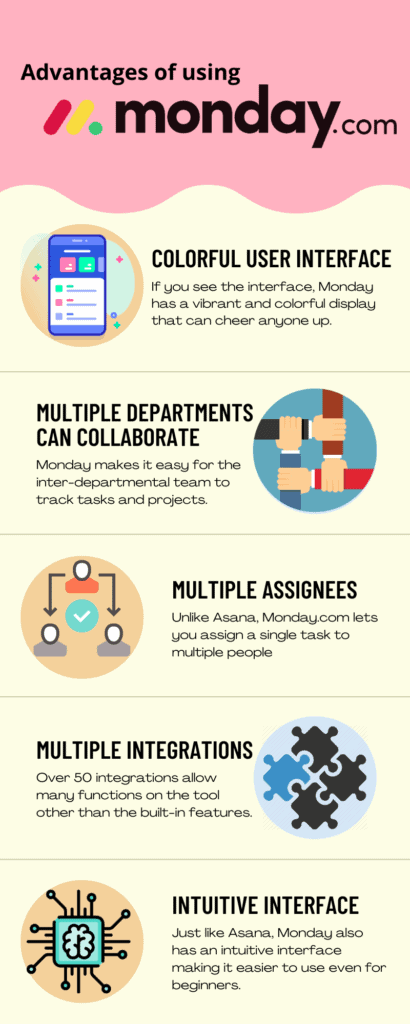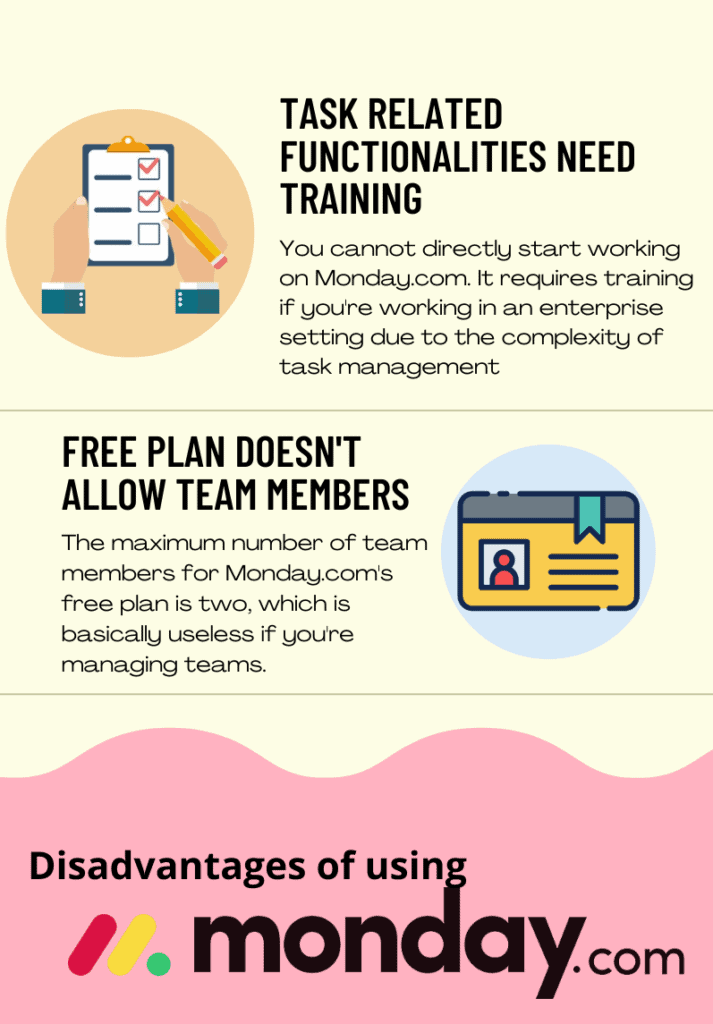Despite the turbulent periods of quick progression, one factor stays constant: people adore project management software. They cling ferociously to their favorite program. It’s time to come together and discuss two of the most outstanding project management solutions – Asana vs Monday in a non-partisan manner.
While both project management services are straightforward, easy, and packed with valuable features, one may seem to offer a lot more. This article talks about Asana vs Monday in great detail, taking into account key factors to help you make an educated decision.
What is Asana?
Asana is a Task Control Software that helps organize your tasks, keep accurate records, and effectively manage all initiatives using one program. Instead of sending back and forth emails, this program facilitates establishing a consolidated dashboard for notification communication.
Using this software, you can give particular assignments to the most specific, unique group of people based solely on their abilities, resulting in sincere mission management.
You can monitor your project’s development using calendars, lists, Gantt charts, and Kanban boards. A Gantt chart is a chart with two axes where the horizontal one shows a project’s timeline, and the vertical one shows all tasks that look like bars.
In the Kanban board, a project looks like a board where tasks look like cards in columns. It means that one card is one task. Projects can consist of as many columns as required. Each column corresponds to a stage of your plan.
Kanban boards are better for repetitive work (work with similar steps), while Gantt charts are better for combining different types of work. The image shows a Kanban board on the right and a Gantt chart on the left.
Asana is extensively utilized worldwide as a project management tool due to its simplicity.
What is monday.com?
Monday is an all-inclusive online management software that promotes collaboration through a visualization tool that makes team members aware of their commitments and time restrictions.

In addition, monday.com is a space where teams can track tasks, collaborate on every project step, view progress through statistical data, schedule events, and store everything on one platform. Monday also provides integrations, making it an absolute must for teams collaborating in a dynamic environment.

This simple software offers a consumer-friendly interface for managing ad campaigns, fixing errors, solving issues, attracting customers, and producing motion pictures.
Asana vs Monday: Differences in Basic and Advanced Features
Asana offers various views, including calendars, Gantt charts, boards, etc. Aside from basic task handling, Asana includes many utilities, including team collaboration and management.
Monday supports a variety of built-in Kanban boards, including workload, list, Calendar, and Timeline. Monday has many features, but it lacks the agility required to implement Agile Frameworks other than simple Kanban.
Asana vs Monday can also manage team projects, tasks, missions, and to-do lists and assign team members to specific jobs (or projects). Both Monday and Asana sites will collapse features to match your screen size when using a smaller screen without leaving out essential details.
Here is an image showing the timeline feature in Asana:
Monday and Asana enable you to see the status of your projects via a timeline. The timeline function displays your to-do list directly above your dashboard on Monday.com, but you may also collapse Timeline from the screen.
Here’s how a timeline looks on monday.com:
A timeline indicates the tasks as spanner bars positioned across a color-coded calendar, indicating the days you must finish the work. You can drag and drop charges to change the project’s schedule or due dates and expand and constrict the Timeline bars to cover more or fewer days.
You must manually activate notifications to inform your team about changes. Monday does not start notifications automatically like Asana.
Asana vs Monday: Task Management
Asana permits you to create tasks, assign them to team members, establish deadlines, and link them to other tasks. Tasks expand to reveal more information where you can add @ mentions, attach documents, and comment.
After signing in, Asana displays tasks due soon in the Home section, and you can see a comprehensive list of all tasks you’ve been assigned by visiting My Tasks.
You can see Pulses as cards in Asana, but they don’t always function that way. Monday.com allows you to create Pulses, similar to Asana tasks that you can name, assign them to a team member, set their status, link them to other Pulses, and view a progress bar showing how long it will take.
Asana vs Monday: Workflow Management
Asana workflows are organized into “views.” ‘Views’ show you how your projects are progressing using lists, Kanban boards, Gantt charts, and calendars, to name a few.
Because you can’t skip any steps when working on a big project, you can rely on task dependencies to keep you on the straight and narrow. In addition, you can move tasks around simply by dragging them.
Monday.com works the same way, except it displays various visualizations for Pulses without forcing you to switch between web pages or browser windows frequently.
You can see the status of your Pulses in a Monday.com user interface (UI) list view using a small progress bar at the top, and display them in the section above the fold in the visualization of your choice. This allows project managers to keep an eye on everything without being overwhelmed.
The Pulses statuses can be changed using a drop-down menu in the list part of Monday.com, but you can also resize and expand them using their timelines (Gantt bars) or by dragging and dropping cards through the Kanban boards. Projects can also be visualized as maps and pie charts.
Asana vs Monday: Portfolio Management
Portfolio Management encompasses the overall management of all the company’s ongoing projects in one location. Asana and Monday are two of the few PM tools to offer Business Portfolio Management. Here’s how both tools accomplish it:
Asana provides a portfolio feature replicating a standard project management tool for projects rather than individual tasks. Using this feature, you can pull back from your day-to-day workspace to see the larger picture and ensure that you don’t lose track of your ongoing projects.
Monday.com’s similar feature, Groups, allows you to add a new Pulse to a Group anytime you create a Pulse on Monday. Because Pulses are open-ended and undefined, you can use them in whatever way you want. Groups are neither tasks nor projects. When you create a Group in Asana, you create a project with a Pulse for each project.
Because Asana’s portfolio feature provides more detail and information, managing your portfolio in Asana is more straightforward than in other project management tools.
Asana vs Monday: Signing Up and Tool Setup
It’s simple to begin with either Asana or monday.com. You need to enter your work email, hit enter, and you’re in. Neither service requires you to enter your credit card details to obtain their free trials. You can freely test monday.com for 14 days or Asana for ten days. Before using your new dashboard, you must verify your email address.
Asana has a “Tour” tab you may click on or tap to discover what you should do next, which is convenient. If you want a quick answer, you may ask an Asana representative by using the chat popup on the bottom-right corner of your screen. You may also ask for assistance by browsing through Monday.com’s YouTube channel if you are stuck and need some help finding out what to do next.
Asana vs Monday: Automation
Asana can save your team time by automating repetitive tasks, freeing them to focus on more important matters. You can use Monday.com’s Automation to trigger an action (such as sending a notification) based on an event inside the platform (such as changing a status). Alternatively, you can use rules to automate routine tasks.
Asana vs Monday: Ease of Use
Asana strives to make its project management software accessible to as many people as possible, and it shows. Asana sticks to a more conventional design with its user interface, which offers a single left-side menu listing all of the application’s key destinations, such as the home dashboard, messaging inbox, and task lists. It would be difficult to get lost while working with Asana.
Asana’s minimal functionality is one of the reasons it is so simple to use. It does not offer financial or reporting features and is designed as a collaboration tool rather than a complete project management solution.
Instead of using the standard approach of listing tasks and checking off steps (like most project management systems), monday.com employs an equally straightforward approach to listing every one of its functions and tasks.
Everything is publicly available and easy to find, resulting in an unbeatable user experience. Setting up everything doesn’t require special plugins, add-ons, or integrations. Reporting and finances are included among monday.com’s most famous collaboration software offerings. This makes monday.com a clear winner compared to most of its rivals.
Asana vs Monday: Customer Service and Support
There are helpful video tutorials about Asana and Monday.com’s YouTube channels on customer service and support. You can also find articles, guides, documentation, and phone numbers on their channels. Both vendors are quick, responsive, and convey that they know what they are doing, which means that the customer support personnel for both platforms are pretty competent.
Asana’s Project Management tool doesn’t provide an email or phone number right away, but you can get round-the-clock live walkthroughs or on-demand tutorials to get a walkthrough of the tool. Monday.com offers free webinars that you can attend to learn more about their product. You can also get live assistance to help you solve issues whenever you’re stuck.
Asana vs Monday: Pricing
Asana and Monday.com offer pricing models that vary according to the number of user licenses required. Asana is a little more costly than Monday, but both companies offer a free plan.
What Asana offers
You can get Asana for free with up to 15 members. Aside from the free version, Asana provides plenty of functionality in project management tools. It offers the following plans:
- Basic: Asana’s basic plan is free to individuals or small teams of less than 15 people and includes unlimited storage, mobile app accessibility, and unlimited projects.
- Premium: Asana’s premium plan costs $10.99 per user per month, allows for form and dashboard creation, and invites an unlimited number of free guests.
- Business: Asana’s $24.99 per user per month business plan includes advanced Salesforce and Adobe integrations and customizable forms.
- Enterprise: Asana’s Enterprise plan includes user provisioning and de-provisioning (SCIM) and priority support, aside from the fact that the two plans are nearly identical. Pricing for Asana’s Enterprise plan is not on their website.
What Monday offers
Rather than having a few pricing tiers and pricing the software based on users, monday.com takes a slightly different approach to pricing.
You can track your work using monday.com’s plan, including the Basic plan’s features. This plan serves individuals who want to follow their work well, with two seats and a 200-item limit. You may sign up for the 14-day free trial without a credit card to try it out.
Apart from the free plan, Monday offers the following plans:
- Basic: The $8 per user per month plan is for solopreneurs and smaller businesses. It includes creating and distributing custom forms, dashboards (one dashboard per dashboard), unlimited free users, and iOS and Android applications.
- Standard: The Standard plan is for small-medium teams. It includes every feature of the basic plan and costs $10 per user per month. In addition, it has Timeline and calendar views, Advanced search functionality, and Automations and Integrations.
- Pro plan: It costs $16 per user per month and covers all the basic and standard plan features. In addition, it includes Private boards, Chart views, Time tracking, etc.
- Enterprise: It is available to large organizations seeking enterprise-level project management software and security. This plan includes every aspect of the other plan, plus enterprise-level security and governance, 250,000 automates per month, in-depth analytics and reporting, multi-level permissions, customized onboarding procedures, priority help, and up to 50 boards on each dashboard.
Asana and Monday have enterprise pricing levels with premium support, security, and governance, among other things. Contact their sales teams for more information.
Asana vs Monday: Data Security and Privacy
All enterprise-based solution providers should be concerned about digital security. However, Asana and Monday have assured their clients through well-known security compliance.
Asana adheres to SOC 2 and ISO/IEC 27001:2013 standards. Enterprises are not permitted to operate the software on their servers; it is cloud-based and has firewalls to safeguard clients from security issues.
Monday.com uses Amazon Web Services (AWS) to maintain client information. In addition, the Google Cloud Platform security procedures are utilized. Furthermore, the company has adhered to ISO 27001 and ISO 27018 standards.
We can see that both providers are seriously protecting their customers’ data.
Asana vs Monday: Integrations
Source
Asana has more integrations than other project management systems, and that’s a fact. Asana provides over 100 integrations, from Dropbox to Slack, GitHub, and Mailchimp. Zapier, as well as Asana’s API, are also integrated.
On the other hand, 40 integrations are provided in addition to its API by Monday.com. These integrations include Slack, Jira, Shopify, Zapier, and Mailchimp. These may be all you require for smaller companies, but you may need to set up data sharing over the API for larger corporations.
Asana vs Monday: Templates
Asana has over 30 task templates for various industries and usage scenarios. You may also save and retrieve custom templates in the templates folder. Monday.com, on the other hand, does not allow this. You will, therefore, have to create tasks from scratch every time, even if they are recurrent.
Asana vs Monday: Reporting and Analytics
With Asana, you can monitor job progress, including calendars, Gantt charts, lists, and Kanban boards. Asana provides simple, eye-catching charts with limited customization options similar to its task management tool presentation. New charts are simple to create and configure, but sophisticated users may be dissatisfied.
With Monday, you can check job progress in one place, eliminating the need to switch between detailed project status screens and broad-sweeping ones. You may move around this interface to see Kanban boards, Gantt charts, timelines, and other projects.
Using other data visualization tools, you’ll feel more at home on monday.com, where you can utilize powerful filters, groupings, and chart types.
Asana vs Monday: Which tool is better for you in 2022?
Monday.com and Asana are suitable for non-technical departments, particularly Sales, Marketing, and similar ones. If you want to design an enterprise communication and collaboration tool with strong job handling capabilities, Asana is your best option.
Monday.com is the one for you if you need a user-friendly Project Management Tool that is fun to use, visually pleasing, and has decent job handling capabilities; Monday.com is the one for you.
The amount of money and time you must invest in these Project Management tools is significant. Moreover, if you’re a software company, you must put Agile implementation aside if you want to use these two tools.
Wrapping Up
In terms of integrations and customization, Asana outperforms Monday.com. However, Monday.com has lower costs and interfaces in comparison to Asana. Even though both project management software is created for small and medium enterprises, their structures are nearly identical.
Choosing the proper project management program is mainly dependent on your personal preferences and company demands. Hopefully, this evaluation has assisted you in selecting the right solution for your venture.



